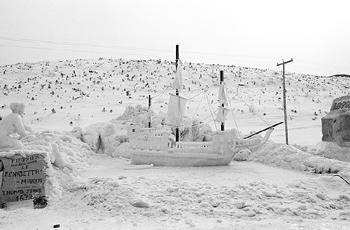 |
 |
| HOME | INFORMATION | ARTICLES | RESOURCES | DIRECTORY | SITE MAP |
Gentlemen, start your ice augers!
THE THREE - INCH RULE The most important basic rule is: Wait until at least three inches of solid ice forms. This will usually support one person of average build. Four inches will generally support several anglers traveling in single file. If you plan to drive on ice, wait for at least nine to 10 inches to form. If the ice is slushy, double these figures. Ice on rivers and near springs or structure such as rocks or logs will also be weaker. Exercise caution. TACKLE AND GEAR The most crucial item is an ice-cutting tool. A spud or a long, heavy chisel will work on ice 10 inches thick or less. For thicker ice, you'll need an auger, either manual or power. A skimmer removes the chips and slush once the hole has been cut. For a seat that also doubles as a gear carrier, try a fivegallon plastic bucket. Other items worth packing include a gaff, rope, sunscreen, sunglasses, stove, lunch and hot beverages; a depthfinder for locating fish and structure is optional. A portable shelter comes in handy if the weather is extremely bitter, and a sled or toboggan is good for hauling gear You can use short ice rods, tip-ups or a combination of the two. A tipup consists of a cross-frame that holds a spool of line down in the water, with a hook and bait attached at the end of the line. When a fish hits, it trips a spring attached to a flag above water. Tip-ups are used mostly for larger fish such as pike, walleyes and bass. Thin and supple line is best for most icefishing. Berkley even makes a special line called Cold Weather Trilene. For panfish and small trout use 1- to 4-pound-test; for bass, pickerel and walleye, 6- to 10-pound; for northerns, 12- to 20-pound. COLD CALCULATIONS Dawn, dusk and after dark are peak feeding periods, particularly for walleyes, trout and crappies. Bites can occur at any time, though, and midday is often good for pike, pickerel, perch and bluegills. Concentrate on areas that were productive prior to freeze-up. And remember: Be mobile don't just cut a few holes and sit there all day. Try a spot; if it doesn't produce after a half hour or so, move to another Be versatile as well. Use a variety of lures and presentations. Concentrate on the bottom, but test all depths. Try vigorously jigging and just barely shaking the lure or bait. When possible, use a combination of tip-ups and jigging rods to increase your chances of finding and catching fish. |
Copyright 2026 Jiffy-on-ice.com All rights reserved.
|
 If you live in the northern half of the United States, winter often means icefishing or no fishing. Lakes and ponds are locked up solid, but the fish below that frozen surface are ready and willing to take a carefully presented lure or bait. The attraction is so strong that more than 2 million people venture out each year. Here are some of the basics to get you started.
If you live in the northern half of the United States, winter often means icefishing or no fishing. Lakes and ponds are locked up solid, but the fish below that frozen surface are ready and willing to take a carefully presented lure or bait. The attraction is so strong that more than 2 million people venture out each year. Here are some of the basics to get you started.